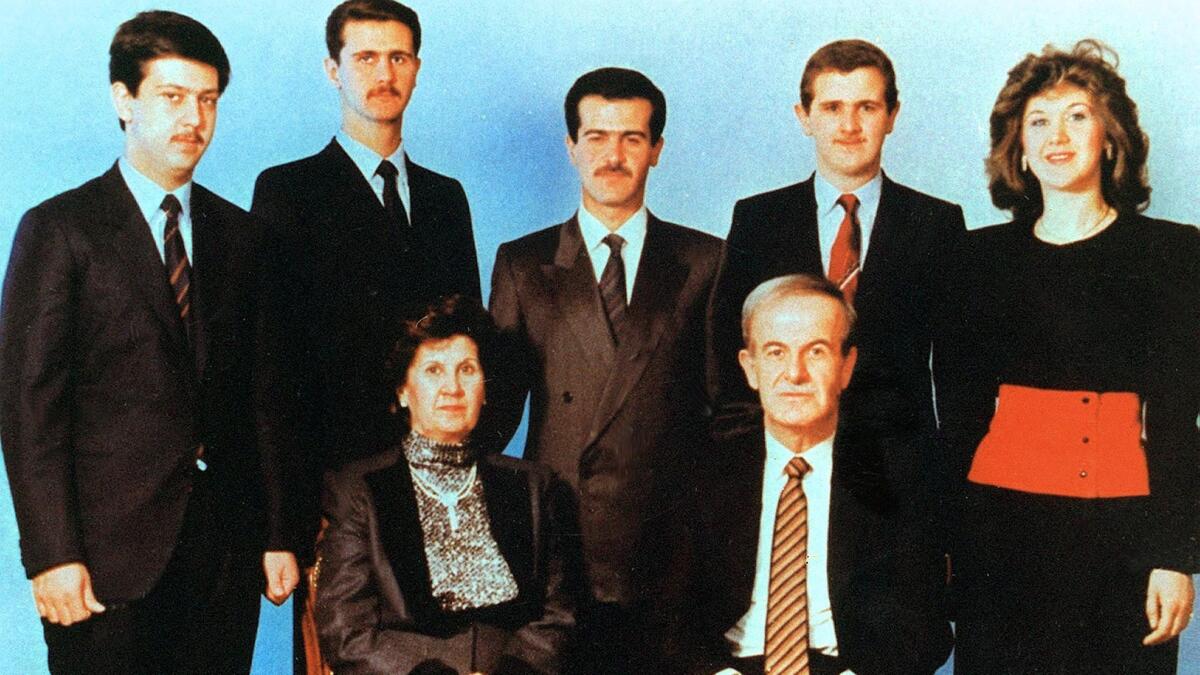Review: ‘Inside Syria’s Deadly Dynasty’ is a chilling portrait of the rise of brutal dictator Bashar Assad

“Inside Syria’s Deadly Dynasty,” a fascinating two-hour special that airs Sunday on the National Geographic network, documents the rise of Syrian President Bashar Assad from an unassuming London eye doctor to a brutal dictator who is feared in his own country and across the Middle East.
The documentary is a behind-the-scenes look at a man whose name has become synonymous with the last decade of unrest in Syria. Americans know him as the enigmatic figure who has seemed eerily calm no matter the atrocities being committed by his forces, but this documentary provides a deeper understanding of how he’s been able to hold on to power despite international outrage.
The film chronicles the Assad family’s reign from 1970 to present day with an emphasis on how, under Bashar’s leadership, the country lapsed into a civil war that’s taken half a million lives — the vast majority civilian — and caused one of the worst humanitarian crises of the 21st century. As president, he oversaw the chemical attacks of his own people, the air bombings of civilian neighborhoods and the torture and killing of anyone, including children, who dared to oppose him.
Mixing narration with firsthand accounts, “Inside Syria” paints a fascinating and disturbing picture of an enigmatic ruler whose gentle public persona is at odds with the ruthless tactics he’s used to stay in power. In archival and original footage, interviews from outside sources with Bashar and his wife, Asma, and exclusive sit-downs with dissidents, former friends of the ruling family, foreign diplomats and others, the documentary tells the story of Bashar’s unlikely succession to power — and what that’s meant for the fate of Syria.
“Inside Syria” starts with the story of Bashar’s father, Hafez Assad, who was born into the poor Alawite minority and worked his way up through the military. He took over in 1970 on the back of a military coup, and as president was known as a strongman who ruled with an iron first. He primed his eldest son, Bassel, a soldier whom many describe as a natural-born leader, to be his predecessor. But when Bassel died in a car crash in 1994, Bashar became the reluctant alternative.
Hafez’s second choice for the throne was studying in London to be an eye surgeon when he was called back to Damascus. In contrast to his late brother, the lanky, awkward Bashar was unsure of himself, rarely made eye contact and still speaks with a lisp. Many saw him as soft, so Hafez fast-tracked his son through the military before his death in 2000.
Sources throughout the documentary explain that Bashar’s first real challenge was the 2003 invasion of Iraq. Allied forces were there to take down Saddam Hussein, a fellow strongman. He saw the writing on the wall and released hundreds of Islamic extremists from Syria’s prisons, armed them and sent them over the border to fight the U.S. and allied troops. The idea was to sow chaos and destabilize U.S. efforts. It worked.
By the time the “Arab Spring” reached Syria in 2011, Bashar had transformed himself from an unsure heir to an unpredictable despot. His forces assassinated high-level opposition in Lebanon, and despite international calls for accountability, he got away with murder. It was a valuable lesson for the leader on how he’d deal with his own people’s dissent, even as the world watched.
He quashed protesters’ calls for a more representative government by any means necessary: jailing civilians, opening fire on dissenters, torturing and killing “enemies of the state.”
The Nat Geo documentary deftly marks the contrast between Bashar and other tyrannical leaders in the region by showing his proclivity as a PR master. He and his wife Asma hired damage-control teams to maintain their image as symbols of modernity and level-headedness in an otherwise troubled and tribal region. They speak with British accents and prefer the styles of Europe over regional dress. The Assads arranged fluff-piece interviews with a few outlets at the height of the civil war, and the footage from those interviews is eerie.
In one of the interviews, a European reporter sits in the car with the happy husband and wife as they drive up to their mansion, giggling and joking about how Bashar loves to take long drives with the family and listen to the radio.
His outward persona helped in dealings with U.S. presidents, presenting himself as an ally who would forward our interests in the Mideast. But he’d learned the old bait-and-switch routine from his father: placate them then do exactly the opposite. It’s part of an MO that’s allowed the Assads to remain in power during nine American presidencies.
The Islamic radicals he released, however, came back to Syria in the form of Islamic State and threatened to overthrow his regime. He almost lost control of the country until he partnered with the Russians, and the rest is history. If you want to know why a man like Bashar Assad is still in power today, watch this compelling documentary.
‘Inside Syria’s Deadly Dynasty’
Where: National Geographic
When: 9 p.m. Sunday
Rated: TV-14 (may be unsuitable for children under the age of 14)
More to Read
The complete guide to home viewing
Get Screen Gab for everything about the TV shows and streaming movies everyone’s talking about.
You may occasionally receive promotional content from the Los Angeles Times.







